Yinyoo V2 – Another Review
Pros: Satisfying bass; sturdy build quality; 2-pin connector; good value.
Cons: The strong bass is a matter of personal preference.
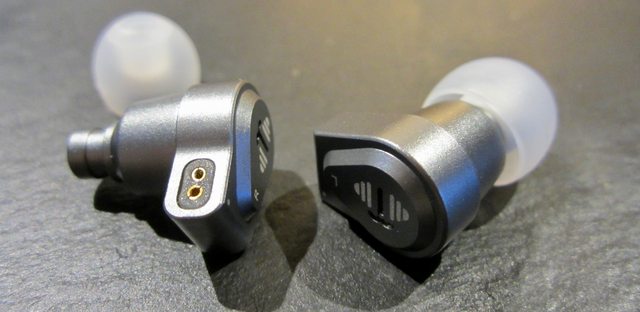
Executive Summary
The two-DD (dynamic driver) V2 is a well-built and well-balanced, and an overall solid performer that caters to listeners who prefer a warm, mature sound with a beefy low end.
Disclaimer
This is my first review on this forum. It started over at Head-Fi last April when an aliexpress seller exchanged a faulty earphone out of warranty and jokingly mentioned I could review it – that was the Tinaudio T2. So far, I have reviewed 19 items retailing between $8 and $88 – and most of them were supplied to me for a symbolic fee/essentially free. Hoarding freebies will eventually constitute a conflict of interest imo – especially when the review units are getting more expensive. I therefore decided to give most of my review units away (the few I am still holding on to for now are either heavily modded or I am still waiting for filters to improve their sound) and am presently looking for a local charity to put them to good use.
This particular review unit was sent to me by Yinyoo’s aliexpress store. They contacted me, and before I could find a home for the review, I had received it (Yinyoo are banned on Head-Fi for alleged review tinkering – or, so I speculate, for not buying a sponsorship). Therefore, I could not negotiate terms with Yinyoo such as including a return envelope and would like to pass it on to good use, primarily to someone who cannot afford such an earphone. The alternative would be to add it to a loaner program to be sent around and being enjoyed by as many as possible. Dear admins, please contact me if you have an idea (postage without the box within Canada is a reasonable $1.80).
The regular price of this earphone is $49 , but members will get it for $39 through their aliexpress store. Send me a PM if you want to know how to do that – no affiliate link involved.
Frequency response curves: the measuring coupler was two pieces of plastic tubing on the end of a Dayton iMM-6 microphone. No compensation or smoothing was applied. These measurements should not be directly compared to other measurements except those done on the same device, for example the ones I have posted before.
Introduction
The Yinyoo V2, a single DD (10mm) with a unique dual diaphragm, suspiciously looks like the neutralish tuned and well-respected Tinaudio T2. It appears that Yinyoo try to offer a warmer alternative to listeners who found the T2 too neutral, analytical, and sterile sounding – and I will show in the following whether this works.
You will find the specifications on the company’s site (link below). The V2 comes with a detachable 2-pin cable and a selection of rubber tips, of which the largest worked well for me. I listened with my iPhone 5S and covered a whole cross section of music including naturally produced sounds by string and wind instruments.
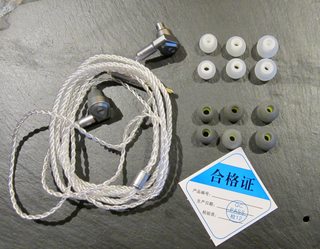

The earpieces are made of metal (and are lighter than the T2’s…and comfortable) and the 4-core cable is of good quality. No concerns here. In terms of fit and seal: these can be worn with the cable down or above/around ear. Fit and isolation are fairly standard for such a cylindrical design.
Tonality
In terms of sound, the V2 does offers a warm, balanced sound with a pronounced low end that is well extended into the sub-bass. The sub-bass is not overly focused and the bass sensu stricto has an intermediately fast decay. Factoring in its healthy punch, you get a satisfying listen (like a bouncing tennis ball). This low end also adds warmth to the overall image. As a consequence of the prominent bass, the lower midrange is somewhat recessed: vocals are a bit back but they have a good, warm timbre. The bass also bleeds a bit into the mids but that is expected. The upper midrange is elevated which adds definition. The treble extension is ok (but not the greatest around) and has enough sparkle. There is no sibilance and other unwanted harshness.
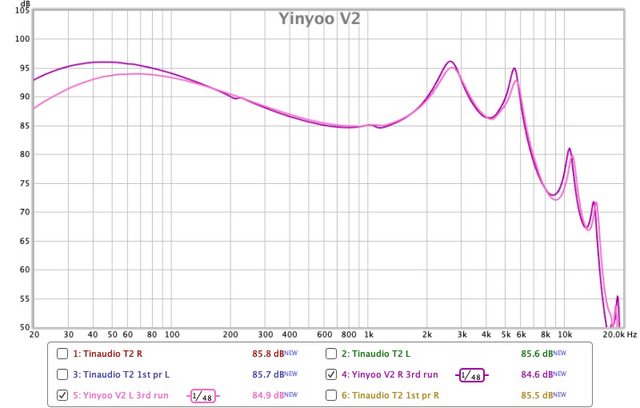
Soundstage is good class average, not too deep, and the prominent bass prevents it from being larger. Clarity, resolution, layering and instrument separation are all good but slightly diminished by the strong bass.
Comparison
The trick question is how the Yinyoo V2 holds up against its older stepbrother Tinaudio T2 (which is heavier and features the unreliable MMCX connectors…I am already on my second pair as mentioned above).
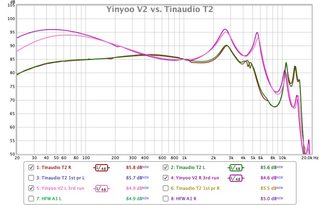
OK, the biggest difference is the more minimalistic and more focused “audiophile” bass in the T2 which many didn’t like. The T2 offers a more forward lower midrange with slightly softer and more organic voices. In comparison, voices in the V2 are sharper defined and a tinge brighter. And the treble in the T2 is more extended. In terms of soundstage, the T2 offers slightly more width and depth – and therefore a better sense of space – because of the lack of bass interference. However, all these differences (except in the low end) are only nuances that play essentially no role in everyday listening – and should neither be a dealmaker or deal breaker.
I used the V2 during my commute. What worked well was the bass counteracting the low-frequency street noise that is hard to filter out even with a good seal. That’s where bassy earphones shine.
Last but not least, I taped the T2’s front vents off and compared them to the V2. The frequency response remained the same above 400 Hz, however there was much energy to bass and sub-bass added.
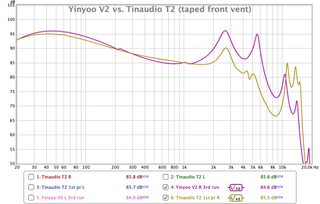
Comparing the taped T2 with the regular V2 also yielded a surprise as their frequency responses below 1.3 kHz are virtually identical, but I find the taped T2’s bass boomier and also more and overly powerful.
Concluding Remarks
In summary, the Yinyoo V2 is a great alternative to the established Tinaudio T2 for bass lovers. While there are differences in the midrange and treble between the models, these differences are small enough only to be relevant for analytical listening but not for everyday use.
But the V2 is also a safe alternative to the many multi-drivers in this price range that may suffer from unwanted treble peaks and artificial sound from their balanced armature drivers and half-baked crossovers.
You can purchase the Yinyoo V2 here:
Amazon.com
Aliexpress
Oh…and soon I may have my own blog…working on it.











